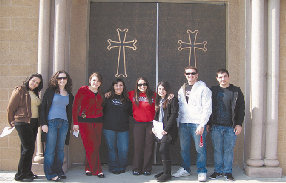Gina Jelladian
Staff Reporter

What are the major feast days celebrated in the Armenian Church? What are the four true marks of the Orthodox Church? How often is the Holy Oil (Muron) prepared? What is it used for?
These were some of the questions faced by students on a quiz taken during the first session of a weekend class, Armenian Studies 120T-The Armenian Church, held on Friday, February 8th and Saturday February 9th. The course was taught by professor and deacon Barlow Der Mugrdechian. The class discussion included a detailed history about the Armenian Apostolic Church and its role as a unifying factor among Armenians. The students in the class learned a lot about the significance of the history, sacraments, liturgy, and worship of the Armenian Church.
In studying the history of the Armenians, one must understand their devotion to Christianity, which was spread in Armenia in the first century by Saints Thaddeus and Bartholomew. St. Gregory the Illuminator converted King Drtad to Christianity in 301 A.D., thus the Armenians became the first Christian nation in the world and Christianity unified the entire Armenian Diaspora until the present day. Catholicos Karekin II, resides in the spiritual capital of Holy Etchmiadzin, in Armenia.
When asked why he was taking the course, Arman Kalamkarian said, “I took this course because it’s necessary to fulfill my Armenian Studies Minor. Aside from necessity, I’m glad I took it, because although I am an extremely active member in the Armenian community and church, I was still able to learn a great deal of information about the history of our people. Prof. Der Mugrdechian is an encyclopedia of Armenian history and that’s part of what makes him such a great professor.”
In addition to learning the history and practices of the Armenian Church, other issues were also discussed. Students had the opportunity to present questions relating to the Armenian Church that they felt were important. Several students asked about the administrative division of the Church in the United States, and how it had developed.
For historical and political reasons, the Catholicos often moved. By the thirteenths century the Catholicosate had been established in the Armenian kingdom of Cilicia. After the fall of the kingdom in 1375, there was a movement by the bishops and clergy in greater Armenia to move the Catholicosate back to Holy Etchmiadzin. By 1441, that movement led to the election of the Catholicos in Holy Etchmiadzin, with the continuation of the Catholicosate in Cilicia. During the Armenian Genocide, the Catholicos of Cilicia fled and established his new headquarters in Antelias, Lebanon.
Saturday morning the class learned about how the Holy Muron (Holy Oil) is prepared once every seven years and is distributed throughout the world. They also learned about how a Catholicos is elected, with the participation of both laymen and clergy.
Later that morning students had the opportunity to visit the St. Paul Armenian Church in Fresno to see first hand the architecture and symbolism of an Armenian Church.
When asked what was most interesting about the course, Jennifer Torosian said, “As an active member of my school and church, I was surprised by the amount of knowledge I was able to acquire about the history of our people and roots of our religion. An exciting part of our weekend class was the mini-field trip to St. Paul Armenian Church. As a group we studied the detail and meaning of stained-glass windows and frescoes throughout the church. It was also very interesting visiting the rooms behind the altar, where the priest, deacons, and sub-deacons prepare for their service.”
It was an intensive weekend of learning about one of the most important institutions in Armenian life today.
 Hye Sharzhoom Armenian Action
Hye Sharzhoom Armenian Action